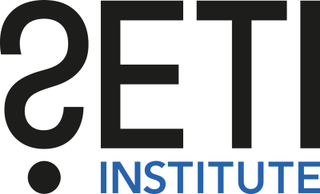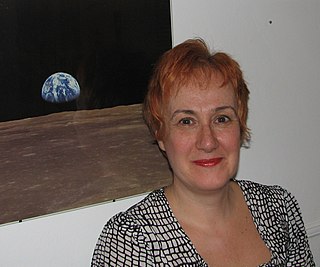
Dr Carl Edward Sagan was an American astronomer, planetary scientist, and science communicator. His best known scientific contribution is his research on the possibility of extraterrestrial life, including experimental demonstration of the production of amino acids from basic chemicals by exposure to light. He assembled the first physical messages sent into space, the Pioneer plaque and the Voyager Golden Record, which were universal messages that could potentially be understood by any extraterrestrial intelligence that might find them. He argued in favor of the hypothesis, which has since been accepted, that the high surface temperatures of Venus are the result of the greenhouse effect.

Frank Donald Drake was an American astrophysicist and astrobiologist.

The SETI Institute is a not-for-profit research organization incorporated in 1984 whose mission is to explore, understand, and explain the origin and nature of life in the universe, and to use this knowledge to inspire and guide present and future generations, sharing knowledge with the public, the press, and the government. SETI stands for the "search for extraterrestrial intelligence".
Doris Daou is a Lebanese-born Canadian-American astronomer who was formerly the Director for Education and Public Outreach of the NASA Lunar Science Institute and the associate director of the NASA Solar System Exploration Research Virtual Institute (SSERVI), and is currently the program contact for NASA's "Small Innovative Missions for Planetary Exploration (SIMPLEx)".

Rosaly M. C. Lopes is a planetary geologist, volcanologist, an author of numerous scientific papers and several books, as well as a proponent of education. Her major research interests are in planetary and terrestrial surface processes with an emphasis on volcanology.

Brian Todd O'Leary was an American scientist, author, and NASA astronaut candidate. He was part of NASA Astronaut Group 6, a group of scientist-astronauts chosen with the intention of training for the Apollo Applications Program.

Alexei Vladimir "Alex" Filippenko is an American astrophysicist and professor of astronomy at the University of California, Berkeley. Filippenko graduated from Dos Pueblos High School in Goleta, California. He received a Bachelor of Arts in physics from the University of California, Santa Barbara in 1979 and a Ph.D. in astronomy from the California Institute of Technology in 1984, where he was a Hertz Foundation Fellow. He was a postdoctoral Miller Fellow at Berkeley from 1984 to 1986 and was appointed to Berkeley's faculty in 1986. In 1996 and 2005, he a Miller Research Professor, and he is currently a Senior Miller Fellow. His research focuses on supernovae and active galaxies at optical, ultraviolet, and near-infrared wavelengths, as well as on black holes, gamma-ray bursts, and the expansion of the Universe.
Dame Carole Jordan,, is a British physicist, astrophysicist, astronomer and academic. Currently, she is Professor Emeritus of Astrophysics at the University of Oxford and Emeritus Fellow at Somerville College, Oxford. From 1994 to 1996, she was President of the Royal Astronomical Society; she was the first woman to hold this appointment. She won the Gold Medal of the Royal Astronomical Society in 2005; she was only the third female recipient following Caroline Herschel in 1828 and Vera Rubin in 1996. She was head of the Rudolf Peierls Centre for Theoretical Physics at the University of Oxford from 2003 to 2004 and 2005 to 2008, and was one of the first female professors in Astronomy in Britain. She was made a Dame Commander of the Order of the British Empire in 2006 for services to physics and astronomy.
The Carl Sagan Medal for Excellence in Public Communication in Planetary Science is an award established by the Division for Planetary Sciences of the American Astronomical Society to recognize and honor outstanding communication by an active planetary scientist to the general public. It is awarded to scientists whose efforts have significantly contributed to a public understanding of, and enthusiasm for planetary science.

Claire Ellen Max is a Professor of Astronomy and Astrophysics at the University of California, Santa Cruz (UCSC) and is affiliated with the Lick Observatory. She was the Director of the Center for Adaptive Optics at UCSC, 2007-2014. Max received the E.O. Lawrence Award in Physics.

Heidi B. Hammel is a planetary astronomer who has extensively studied Neptune and Uranus. She was part of the team imaging Neptune from Voyager 2 in 1989. She led the team using the Hubble Space Telescope to view Shoemaker-Levy 9's impact with Jupiter in 1994. She has used the Hubble Space Telescope and the Keck Telescope to study Uranus and Neptune, discovering new information about dark spots, planetary storms and Uranus' rings. In 2002, she was selected as an interdisciplinary scientist for the James Webb Space Telescope.

David Morrison is an American astronomer, a senior scientist at the Solar System Exploration Research Virtual Institute, at NASA Ames Research Center in Mountain View, California. Morrison is the former director of the Carl Sagan Center for Study of Life in the Universe at the SETI Institute and of the NASA Lunar Science Institute. He is the past Director of Space at NASA Ames. Morrison is credited as a founder of the multi-disciplinary field of astrobiology. Morrison is best known for his work in risk assessment of near Earth objects such as asteroids and comets. Asteroid 2410 Morrison was named in his honor. Morrison is also known for his "Ask an Astrobiologist" series on NASA's website where he provides answers to questions submitted by the public. He has published 12 books and over 150 papers primarily on planetary science, astrobiology and near Earth objects.

Nadine G. Barlow (1958–2020) was an American planetary scientist. She was a professor in the Department of Physics and Astronomy at Northern Arizona University (NAU). She became Associate Chair of the NAU Department of Physics and Astronomy in Fall 2010. She was also the director of the Northern Arizona University/NASA Space Grant Program and an associate director of the Arizona Space Grant Consortium.
Emily Rice is an astronomy professor at the Macaulay Honors College at the City University of New York. In addition to her scientific contributions to the study of the atmospheric properties of low mass astronomical bodies, she has become well known for her astronomy-related public outreach projects. She is the co-founder of the astro-centric fashion shop STARtorialist, a host for the public outreach series Astronomy on Tap, a parody video creator, and a current research associate for the American Museum of Natural History in New York City. She has appeared as a guest on the popular podcast StarTalk (podcast), and was a host for their spinoff show, StarTalk All-Stars. Rice also served as a public presenter at the Hayden Planetarium in New York.

Vesna Milosevic-Zdjelar is a Serbian-born Canadian astrophysicist, science educator and author. Her specialty is teaching astrophysics to students enrolled in non-science programs at the University of Winnipeg.

Marcia Jean Rieke is an American astronomer. She is a Regents' Professor of Astronomy and associate department head at the University of Arizona. Rieke is the Principal Investigator on the near-infrared camera (NIRCam) for the James Webb Space Telescope (JWST). She has also served as the deputy-Principal Investigator on the Near Infrared Camera and Multi-Object Spectrometer (NICMOS) for the Hubble Space Telescope (HST), and as the co-investigator for the multiband imaging photometer on the Spitzer Space Telescope, where she also acted as an outreach coordinator and a member of the Science Working Group. Rieke was also involved with several infrared ground-based observatories, including the MMT Observatory in Arizona. She was vice chair for Program Prioritization of the Astro2010 Decadal Survey Committee, "New Worlds, New Horizons". Marcia Rieke is considered by many to be one of the "founding mothers" of infrared astronomy, along with Judith Pipher.
Sarah Rugheimer is a Swiss-American astrobiologist and astrophysicist at Jesus College, Oxford. Her research focuses on the atmospheric composition of exoplanets, and ways of detecting life.
Melissa McGrath is an astronomer whose expertise is the atmosphere and magnetosphere of the Solar System planets and their moons. Her main interest has focused on imaging and spectroscopic studies of Jupiter’s Galilean moons. She is currently co-investigator on the ultraviolet spectrometer instrument on ESA JUICE mission to Ganymede, and co-investigator on two proposed instruments on the NASA Europa Clipper mission. McGrath is senior scientist at SETI Institute in Mountain View, California.
Linda May French is an American astronomer specializing in the physical properties of asteroids and comets, including their shapes and surfaces. She is also interested in astronomy education and in the history of astronomy, particularly focusing on the life of John Goodricke, an 18th-century deaf British amateur astronomer. She is a professor of physics at Illinois Wesleyan University.
Catherine C. Espaillat is an American astronomer whose research is focused on the formation of planets, including the study of protoplanetary disks and young stellar objects. She is an associate professor of astronomy at Boston University, where she directs the Institute for Astrophysical Research.












